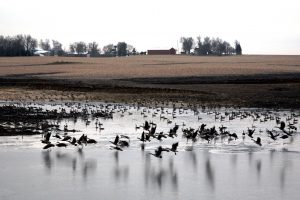The world’s population will likely increase to nine billion people by 2050. That is a whole lot of mouths to feed. The combination of population growth and the world demand for richer diets will require us to approximately double the amount of crops grown over the next four to five decades.
To make matters worse, the nine billion people will occupy more living space, require more infrastructure and use more recreation land, all leading to less land to farm. To feed the burgeoning population with fewer acres will require us to develop more productive and more resilient cropping systems. Dr. Chris Anderson from Iowa State University is today’s guest blogger for Precision Conservation. Dr. Anderson proposes one strategy to increase yields and provide a higher level of environmental sustainability.
Water Capture for Irrigation Has Production and Environmental Benefits
Growers face increasing demand for their product and increasing scrutiny of their practices and the impact these practices have on the environment in the Midwest and elsewhere. In speaking with growers, I am convinced they are looking for approaches to increase production while shaping a more diverse landscape with healthy soil and rivers. Water capture for irrigation is an approach not widely used that would achieve these goals.
In 1989-1990, Iowa State University tested a field-scale water capture and irrigation system* on Clarion-Nicollet-Webster soil with the goals to (1) profitably produce high crop yield, (2) minimize surface and groundwater contamination associated with high yield crop production, and (3) improve wetland and wildlife habitat. Using a design by Kenneth O. Thornton (U. S. Patent number 4,538,377), tile drainage was installed at 3 – 4 ft depth and directed to a 3.6 acre-foot pond. Subirrigation pipes were installed at 1.5 – 2 ft between tile drainage lines and water was drawn from the irrigation pond filled by the drainage tile. Despite using nitrogen rates lower than the average application in Iowa, individual field plots produced as much as twice the state average yield in 1989.
Water capture for irrigation is environmentally, agronomically, and physiologically sound, but its implementation can be complicated. While it is easy to envision how to implement it on small plots, such as those used in subsistence farming or field trials, landscapes of commercial farms are complex with highly variable terrain and soils; some have extensive tile drainage systems while others do not; and, different types of irrigation technology are more effective in different landscapes. This means the costs and expected benefits of water capture for irrigation systems require field-specific design. What I believe is needed is a network of grower peers who want to learn from one another how to implement this technology and under what field conditions goals for crop production, profitability, and environmental benefits will be met.

I recently met with growers who are experimenting with this approach to discuss what a network would accomplish for them. If you are interested in such a network, I invite you to contact me. To the right is an image of a pond being filled this winter to provide water for irrigation on about 300 acres of black soil, where the yield benefit is expected to be 30 – 50 bushels per acre. Iowa is water rich, a situation other states envy. Growers can make this an unbeatable advantage if they consider a sustainable irrigation design as something more than drought insurance.
* Subirrigation and Controlled Drainage, H. W. Belcher and Frank M. D’Itri. Chapter 20, Environmental and Economic Impacts of a Recycling SubIrrigation-Drainage System, S. W. Melvin and R. S. Kanwar.

Scientist, Assistant Director Climate Science Program
Iowa State University
Christopher J. Anderson is a climate risk analyst. He is Assistant Director of the Iowa State University Climate Science Initiative, a research program that provides authoritative, scientific information for short-term and long-term climate-informed decision-making. He holds doctoral and master degrees in agricultural meteorology from Iowa State University
 A quest to improve soil health
A quest to improve soil health
For more on water storage for irrigation in the Midwest see:
Coupling landscape water storage and supplemental irrigation to increase productivity and improve environmental stewardship in the U.S. Midwest. John M. Baker, Timothy J. Griffis, and Tyson E. Ochsner
Water Resources Research, Vol. 48, W05301, doi: 10.1029/2011WR011780, 2012
Thanks Les, I appreciate you providing the information for everyone. I am looking forward to reading the article.
Hi Les,
I agree this article lays the framework for what could be accomplished if adopted across the Midwest. The trick, I am finding, is the expense of this approach. What wasn’t estimated in that article is the potential production increase that is possible from high yield farming. The focus of that article was on the nutrient reduction benefits of the technology. A more complete assessment of costs and production benefits would help growers see that it is possible to take on the front-end cost of this technology.
Chris